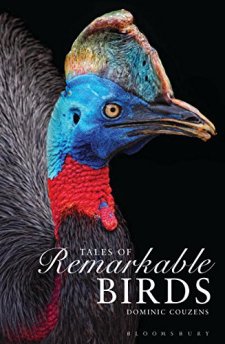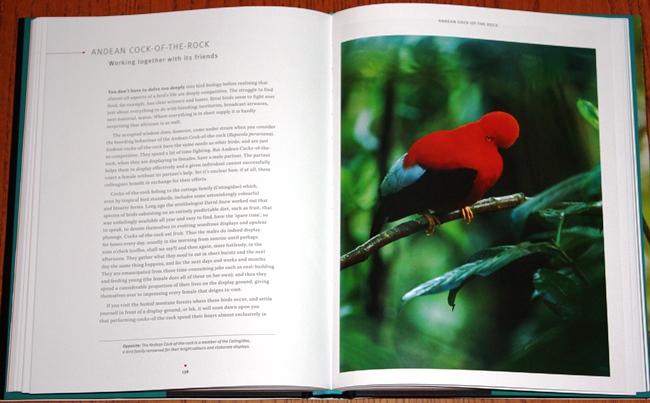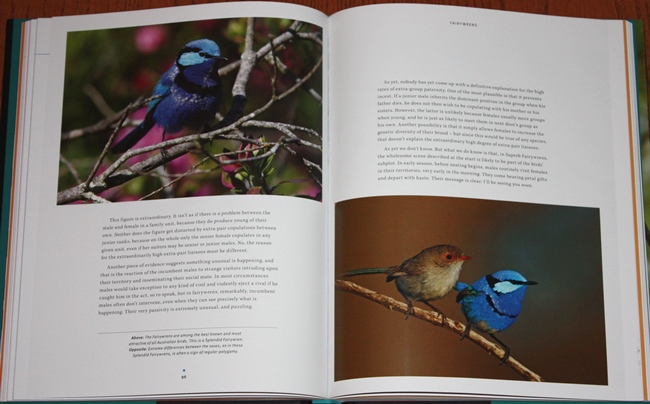Reviewed by Grant McCreary on July 2nd, 2015.
I started this website over eight years ago (eight years!?!?), and was a heavy reader of bird books for a few years before that. I have to admit that after all that time, I sometimes cynically wonder if most new bird books are just rehashes of prior books. Take Tales of Remarkable Birds, for example. This is a mid-sized book comprised of short chapters about bird species and families, accompanied by some gorgeous photography. This isn’t the first of its kind, several similar books have been published previously (see Remarkable Birds for an example). But reading it, I’m reminded that birds are incredibly diverse, with almost as many ways of looking at them as there are species on the planet. Moreover, I find that the more I read about birds, the more I find that I didn’t know about them.
Tales of Remarkable Birds includes 40 accounts of birds or groups of birds (see the complete list below). Each of these chapters is either four or six pages, with a quarter to a half of that space occupied by some fantastic photographs. It would be impossible to provide a satisfying comprehensive account in that amount of space, so Couzens has chosen to focus on one particular thing that makes the species or family, well, remarkable.
Here are a few examples.
Toucans are well known, even by non-birders, for their bills. But why do they have such large, colorful bills? They use them to reach fruit, so by having a large bill they can reach fruit that other birds cannot. That explains the size, but what about the color? It doesn’t seem to be a sexual characteristic, since the bills of both males and females look identical. Researchers, however, have noticed one thing regarding toucan bills – they are intimidating. Other birds, competing for the same fruit as the toucan, seem to give it a wide berth, giving toucans an advantage in foraging. But toucans forage for more than fruit – a significant portion of their diet is meat. They routinely raid the nests of other birds, whose parents often keep their distance. As the author summarizes, “When you watch these bold and colourful birds feeding and ask what the outsize bill is for, the very last answer you expect is that the colour and pattern intimidates parents whose nests the owners are raiding.”
Australia’s White-winged Choughs live in family groups, which is necessary in order to breed in their hostile environment. Since their nesting success is correlated with group size, they sometimes go to drastic measures to increase their clan – kidnapping. During skirmishes with neighboring groups, choughs have actually been observed snatching the rival group’s fledglings and bringing them back to their own territory. Sometimes the victims will eventually return to their original group, but occasionally this gambit works and they will stay with their kidnappers. Now that is truly remarkable.
When you turn the page and see the title of the next chapter is “Rockhopper Penguin: The most unloved egg”, well, you just have to read it. And, if you’re like me, you’ll be glad that you did. It turns out that the Rockhopper has a habit that ornithologists don’t have a sure explanation for: they lay two eggs, but only one usually hatches. Couzens explains that this isn’t the same as brood reduction, which many species of birds practice, where all members of a clutch do not normally survive, except in years of prey abundance. In brood reduction, the last-laid egg(s), which are the ones that have the least chance of survival, can be seen as an insurance policy in case the oldest chicks don’t survive. This system results in the maximum number of young based on the seasonal prey availability. But the Rockhopper Penguins don’t do this – their extra egg doesn’t usually even hatch! And even weirder, it is the first-laid egg that is the “wasted” one. Ornithologists don’t know why this is, but the prevailing theory is that these penguins are in the process of evolving from a species that raises two chicks (as most penguins do) into one that produces just a single egg (like King and Emperor Penguins).
The accounts are organized geographically, with groupings of five chapters for each of the seven continents, plus another for islands. This is a great idea, as no matter where you live you will find birds that are both familiar and unfamiliar to you. Readers in North America, for example, will find familiar backyard birds, such as the White-throated Sparrow and Black-capped Chickadee, that you may discover weren’t so familiar after all. And then in other sections will encounter birds that you’ve never even heard of.
However, despite this organization, you don’t have to read this book in a traditional, linear manner. It may be more fun to simply flip through and see what catches your eye. It could be a chapter title, like the Rockhopper’s “unloved egg”, but more than likely it will be one of the many gorgeous photographs. You may see a photo of a fairywren or sunbird, for example, and wonder “What is that?!?”, and then be compelled to read the chapter.
In fact, don’t be surprised if you keep reading “just one more chapter”. The birds are the true stars of the book, but the author presents them in a way that is both fun and educational. His style is chatty and informal, but that works here. Hard-core birders and complete non-birders can both enjoy these tales.
As fun as Tales of Remarkable Birds is, it would have been better served by some more careful editing. I wouldn’t normally mention one or two lapses, but I noticed no fewer than six missing, repeated, or incorrect punctuation marks or words. The missing words, especially, can make sentences unintelligible or incorrect. Context will usually make the intended meaning clear, but for some you would have to have prior knowledge of the subject not to be misled or confused.
There is, however, absolutely nothing wrong with the photographs here. Each chapter is adorned with multiple pictures, all very nice. Many of them are even full-page. This isn’t a book you would buy just for the photos, but they do a great job of enhancing the text.
Recommendation
No, Tales of Remarkable Birds isn’t unique. But these birds, and the stories about them related by Couzens, are truly remarkable. No matter how much you already know about birds, you will learn a great deal here. I know I did.
Contents of Tales of Remarkable Birds
- Northern Wren
- Great Spotted Cuckoo
- Great Grey Shrike
- Common Crossbill
- Eurasian Oystercatcher
- Sunbirds
- Ostriches
- Straw-tailed Whydah and Purple Grenadier
- Boubous
- Widowbirds
- Greater Racket-tailed Drongo
- Yellow-browed Warbler
- Pheasant-tailed Jacana
- Arabian Babbler
- Swifts and Swiftlets
- White-winged Chough
- Fairywrens
- Great Bowerbird
- Southern Cassowary
- Varied Sittellas
- White-throated Sparrow
- Black-capped Chickadee
- Cliff Swallow
- Harris’s Hawk
- Marbled Murrelet
- Andean Cock-of-the-Rock
- Toucans
- Antbirds
- Tanagers
- Hummingbirds
- Rockhopper Penguin
- Albatrosses
- Emperor and Galapagos Penguins
- Sheathbills
- Wandering Albatross
- Swallow-tailed Gull
- Megapodes
- New Caledonian Crow
- Blue Bird-of-paradise
- Extinctions (Hawaii)
Disclosure: I get a small commission for purchases made through links in this post.
Buy from NHBS
(based in the U.K.)
Disclosure: The item reviewed here was a complementary review copy provided by the publisher. But the opinion expressed here is my own, it has not been influenced in any way.








Good point about how the photos greatly add to the book.
I read this book as an ebook and the photos were very small. As much as that was frustrating, I thought the book was a breezy read but certainly eye-opening and informative.
You would think that an ebook would have the freedom to have larger, or at least expandable, photos!